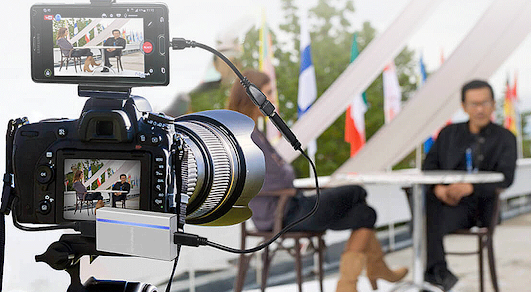
Hi, this is the CameraFi Live team.
CameraFi Live allows you to broadcast with an external camera that supports USB UVC(USB Video Class). You can connect wired cameras such as wearable cameras, webcams, microscopes, and endoscopes directly. Also, your DSLR cameras, camcorders, and drones can be used as a video source in your live-streaming with an HDMI-UVC capture card. If you have a professional broadcasting camera, it is also possible with SDI to UVC capture card.
Recently, there was a big problem where the USB UVC device in the Android OS 10 smartphones was blocked. We were looking for various solutions and provided a separate app to find a way to support USB cameras in Android OS 10 as well. The CameraFi Live team asked the smartphone manufacturers to solve the issue quickly, and it seems to be resolved now in the latest devices. It can be fixed by updating the software. (Related Notice)
For using UVC cameras, you need to connect your camera directly to the USB port in your smartphone. If your camera is a USB type A, you need an OTG cable that fits your smartphone(micro USB or USB type C).
However, to connect a DSLR camera, you need additional supplies.
WHAT SHOULD I PREPARE?
1. Camera with HDMI output
To live stream what your camera is shooting, you need a camera with a clean HDMI output, meaning it does not contain onscreen data indicators such as recording status, exposure settings, battery charge, etc.
Please also check if your camera can output audio as well as video. Some DSLR cameras provide video HDMI output but no audio. In this case, you need to use the microphone from your smartphone as the audio source instead.
2. HDMI UVC capture card
We are currently recommending ExtremeCap UVC - BU110 from AVerMedia. Depending on the characteristics of the mobile environment, the capture card must be designed to operate with a small amount of power consumption from the smartphone. As most capture cards are designed to connect with a PC, problems might occur even though the connection seems to work well at first.

3. USB-C multi-adapter and a portable charger (optional)
If you broadcast with a capture card connected, the smartphone battery will run out quickly. Therefore, some streamers use a USB-C multi-adapter and a power bank to charge their smartphone while streaming live. Please note that low-end smartphones may not work properly due to the heat generated during the power supply.
FAQ
Q1. Is 4K resolution available?
A1. I would say that 4K support is not possible with the current environment. Reading data through USB devices is using a lot of CPU resources. Since decoding, encoding, and network streaming have to be done at the same time, 720p(1280*720) 60fps seems to be the best option even with the latest smartphones like Samsung Note 20 in our tests. If you apply several effects and broadcast for a long time, the frame may drop in Galaxy Note 20.
The CameraFi Live team is working on a project to reduce CPU usage and improve performance. We will work hard to improve smartphone hardware/AP. We believe we will be able to provide 3840*2160(4K) 30fps and 1920*1080(FHD) 60fps one day.
Q2. I cannot see the screen when I connect the USB camera.
A2. We have received this question the most. You should check one by one if your DSLR, HDMI/USB cable, and smartphone work.



If your smartphone does not support the OTG function, the capture card will not be recognized. In addition, smartphones using low priced AP(Mediatek, HiSilicon Kirin, Spreadtrum, low-end Exynos, etc.) might not support the large data transmission via USB.

If you have any questions, please send us the email via apps.help@vaultmicro.com or leave a comment below.
Thank you.


